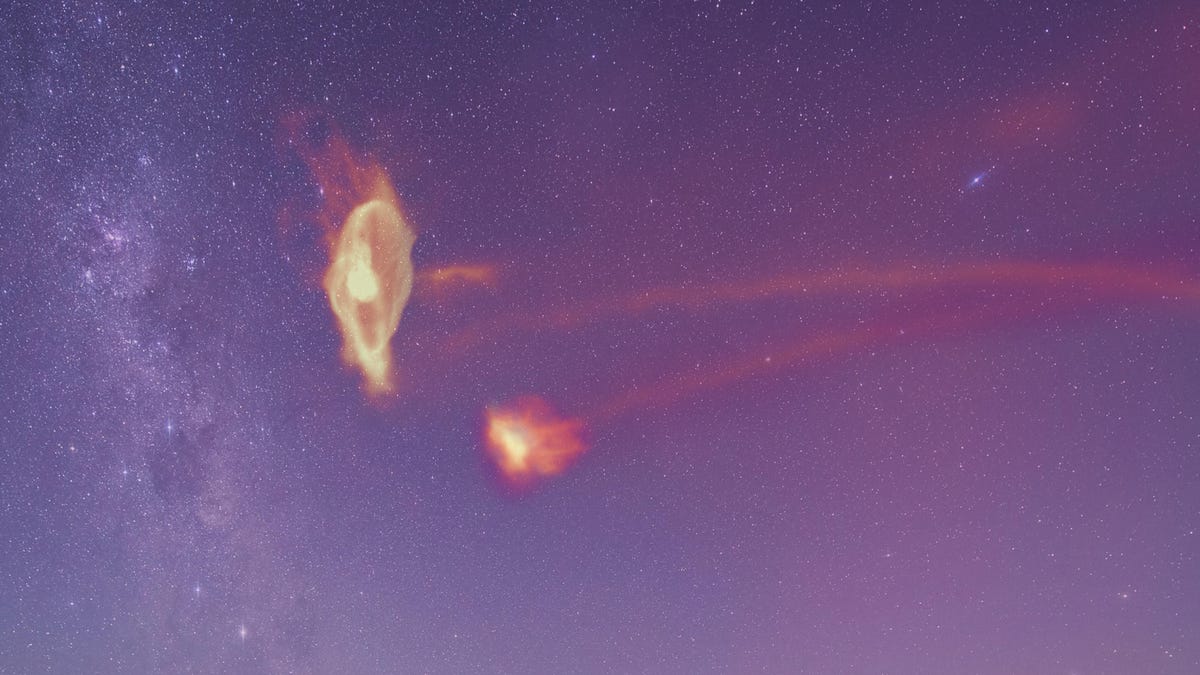Astronomers crack '50-year puzzle' of cosmic stream ripped apart by Milky Way
The Magellanic Stream is a ribbon of gas that wraps around our home galaxy, but its origin story has been elusive.

How the Magellanic Stream might look like if we could see in UV and X-ray light.
The Milky Way is prone to acts of galactic cannibalism. During its formative years, it likely swallowed up another galaxy known as Gaia-Enceladus -- evidence for this feast exists in the galaxy's "halo," an immense spherical region of space that surrounds our galaxy's central disk. And it's not the only evidence of encounters with other galaxies in the halo. A huge ribbon of gas wraps around our home galaxy, a lingering sign of other acts of cosmic brutality.
The ribbon, known as the Magellanic Stream, was first discovered in the 1970s. Researchers believe the stream was ripped from two dwarf galaxies, imaginatively known as the Large Magellanic Cloud and the Small Magellanic Cloud billions of years ago. These two galaxies, filled with billions of stars, orbit the Milky Way, bound by its huge gravity to complete one full swing every billion years or so.
According to Joss Bland-Hawthorn, an astrophysicist at the University of Sydney, the stream consists of "mostly cold and warm gas" but very few stars. It's unusual, and how it came to be has puzzled researchers for decades. Andrew Fox, an astronomer at the Space Telescope Science Institute, calls the stream "a 50-year puzzle." Previous research has been able to account for the size and shape of the stream but not its mass -- the stream contains approximately 1 billion suns' worth of mass, but models can only account for a tenth of that.
So where did this cosmic ribbon come from and how did it get so massive?
New research, published in the journal Nature on Wednesday by an international team that includes Bland-Hawthorn and Fox, has helped answer these questions by using cutting-edge supercomputer simulations. The researchers suggest there is a crucial element missing from previous modeling that could help account for the missing mass: the Magellanic clouds are themselves big enough to be surrounded by a hot "halo" of gas, just like the Milky Way, known as the Magellanic corona.
"Our basic theories of galaxy formation predict such a hot halo around virtually every galaxy with a mass above a certain threshold, comparable to the mass of the LMC," said Thorsten Tepper García, an astrophysicist at the University of Sydney who was not affiliated with the study.
Observational data (left) and the simulation (right) demonstrating the stream's formation from around 500 million years ago until the present day.
According to the research team, there are two stages to the stream's formation. Long before the Magellanic Clouds made their way into the Milky Way's cosmic neighborhood, they danced together, orbiting one another. The Large Magellanic Cloud's gravitational pull siphoned off cold gas from its smaller counterpart over billions of years, warming it up and creating the corona of hot gas. Later, the Clouds were captured by the Milky Way's gravity, and some of the corona fell into the galaxy, being stretched and smeared across the its outer edge.
See also: 7 best stargazing apps for spotting constellations in the night sky
These hot halos also explain another factor in how the Magellanic Stream came to be. In 2007, a study by Bland-Hawthorn and his team suggested the stream should "fade from view" when it hit the Milky Way's hot halo. But it didn't. The new work suggests the corona surrounding the Magellanic Clouds "protects" the stream, pushing the galaxy's hot gas aside and preventing it from fading.
"This work redefines our understanding of how gas accretes onto the Milky Way and forms the reservoir for future star formation," said Bland-Hawthorn.
The new work is only a simulation, but it creates a testable hypothesis.
"Our next step is to demonstrate the existence of the Magellanic Corona with the use of the Cosmic Origins Spectrograph on the Hubble Space Telescope," said Elena D'Onghia, an astrophysicist at the University of Wisconsin-Madison. Using distant, extremely bright galaxies, the team will be able to assess the elements that make up the corona and "unambiguously confirm" its existence.
If they find it, the 50-year puzzle may have finally been solved. And if for some reason they can't get a good look? Well, it's only about 2.4 billion years until the Large Magellanic Cloud crashes into the Milky Way and gets eaten alive, anyway.

